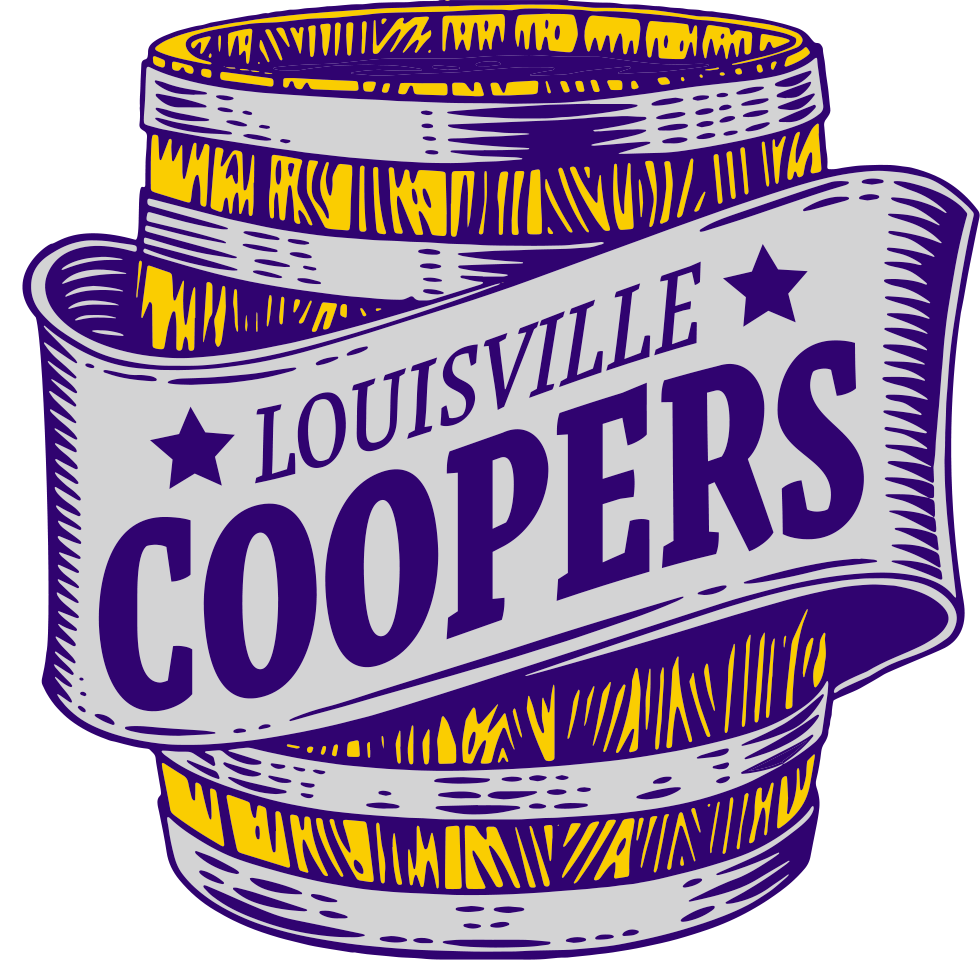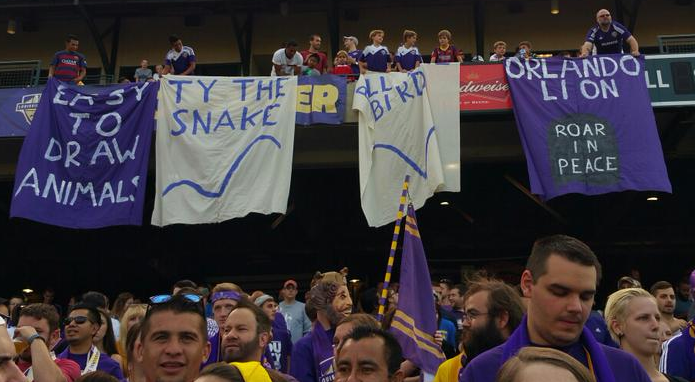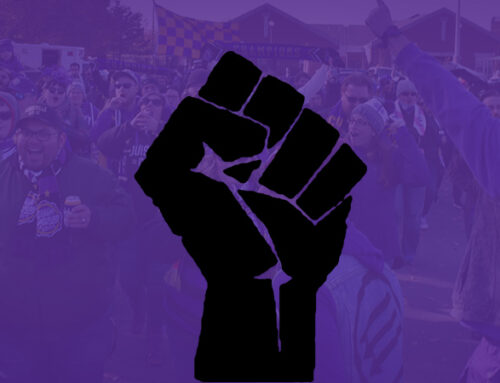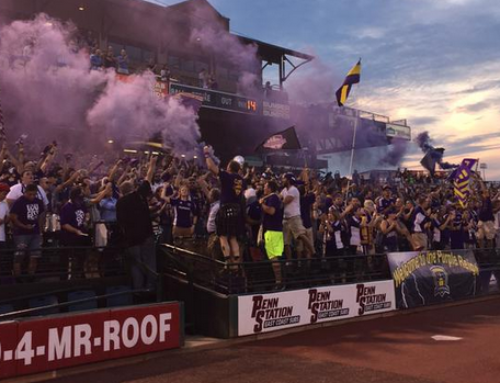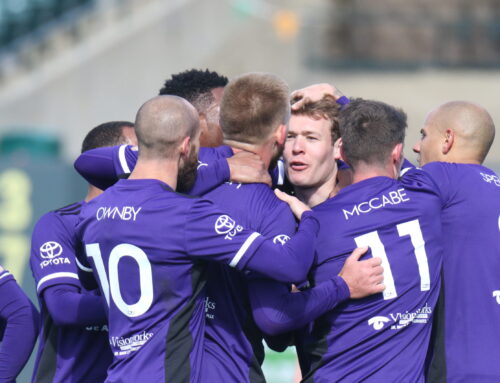By Andrew Oost
The first homestand of the 2019 season is now behind us, and despite the results on the field leaving much to be desired, a warm and familiar feeling was present in the stands and concourses of Slugger Field. Louisville City’s fifth season represents the final run out in their borrowed home ground, one that will not be missed for any outstanding qualities as a soccer pitch, but more for what it represented as the place where the club and it’s community of supporters first came together.
Standing outside the stadium at Against the Grain before the Hartford game, I was momentarily touched by how many now familiar faces I recognized in the crowd. Many were old friends and family, but the majority were people I have met since 2015, solely due to our shared love of Louisville City FC.
It’s no secret that an large but virtually underground population of soccer fans existed in Louisville prior to the arrival of LCFC. I fondly remember watching USA World Cup matches and Champions League Finals at local pubs and being constantly surprised by how many soccer fans were out there, just looking for a place to gather and celebrate the game. Wayne Estopinal realized this and willed Louisville City FC into being, and his vision has blossomed into the rallying point for all soccer fans in our community.
Despite the impressive community of supporters that have coalesced behind the club, being a LCFC fan can at times feel like being a part of an underground subculture. To the readers of this series, it has likely become a way of life, but to much of the rest Louisville, it’s simply a quirky little soccer team with a few purple-clad fans spreading the gospel of their beloved LouCity with missionary zeal.
The final season in Slugger Field represents the end of Louisville City 1.0. The supporters have been an integral factor in propelling the club to the position it currently finds itself in, and should rightfully bask in all the glory that has ensued. We are, however, on the precipice of a new era, one which will find us shoulder to shoulder on the terraces of our new home ground, singing in a new era.
The Contrarian Ethos
One of the constant refrains I’ve heard from newcomers to Louisville City games is that many of the differences between soccer and traditional American sports are the very things that are appealing to them. The march to the match, the smoke, the drums, the songs, the festive atmosphere, the uninterrupted play, and a hundred other nuances that make soccer different than other traditional American sports are what make the game attractive to so many. It seems that the differences are not a bug, they’re a feature.
Never once have I heard someone complain that they missed hearing “We Will Rock You”, “Rock and Roll Pt. 2 (Hey Song)”, or “Whoomp (There It Is)” at an LCFC game. I’ve never heard anyone lament the fact that Lance McGarvey isn’t leading the crowd in chants “D-Fence” or encouraging them to “Make Some Noise”. I’ve never heard a complaint about the lack of television timeouts, halftime entertainment extravaganzas, or that there were no scantily-clad cheerleading squad shaking pom-poms and performing acrobatics..
The only vaguely traditional feature of American sports culture that has even been suggested for Louisville City FC has been a mascot. The reaction from a large subset of the supporters has been rabidly and diametrically opposed to even the faintest mention of introducing a furry, anthropomorphic creature as a symbol of the club. Protecting the club from a mascot is the hill that many of us have half-jokingly threatened to die upon.
The reasoning behind the supporters opposition to such gimmickry is not unsubstantiated, though. Soccer doesn’t have timeouts or periods of down-time that need to be filled with artificial distractions. Paying attention for two 45-minute halves is a proposition that even the most ADD-addled brain should be able to handle without the distraction of tussling with their fellow fans for a Kroger t-shirt fired out of a cannon.
The other, more essential reason that mascots or cheerleaders aren’t wanted or needed is that the stands are filled with them every single game. The most vocal support for Louisville City was present from the start, and has grown organically with minimal direction and input from the club.
It appears club has come into an understanding over the past couple of years that the supporters and the atmosphere they create are, in large part, the actual product that they are selling. LC supporter culture is now featured front and center in commercials, on billboards, and in all manner of promotional material produced by not only Louisville City, but by the USL itself.
There are many factors that might get someone to attend their first Louisville City game. Perhaps an invitation from a friend, a free ticket, a group outing, or simple curiosity would be enough to get them to the stadium for their first game. However, it’s the atmosphere and feeling that they are attending a living, breathing, vital cultural experience that will most likely get them to attend their second.
When The Going Gets Weird, The Weird Turn Pro
From the very beginning, it became was apparent that something was fantastically weird and wild was going on in the Supporters Section. Unprompted by anyone, and seemingly of their own volition, a ragtag cadre of comic book heroes and villains, biker gang lookalikes, kilted men, jesters and ruffians of assorted stripes emerged from the ether to support our new soccer team. It was all in good fun, and had the perfectly chaotic feel of a party that was always going slightly off the rails. It was also quite unlike any sporting atmosphere the city had ever seen.
While some of the cosplay heroes have hung up their capes for street clothes, the spirit remains the same. The Groove Machine bangs harder and better than ever, and the dedicated cast of capos are enthusiastic and inexhaustible. The tifos have been consistently great, culminating in the touching “Wayne’s Louisville” tribute on March 23, and the handful of dedicated “two-pole” artists have continued to raise the bar.
The chants and invocations from the supporters can trend towards the off-color variety, especially if the team is losing. The causes and statements from some of the more outspoken can veer into the realm of the political, and infighting amongst the Purple Family is not unheard of. Regardless, the beer flows like water, the atmosphere is festive, if not downright raucous on a good night, and newcomers are generally dumbfounded that it took them so long to realize what has been happening on Main Street.
So here’s raising a glass to all the misfits and weirdos and delightful eccentrics that have graced the aisles and concourses of the famous soccer stadium, Slugger Field. Your bizarre antics and zany hijinks have never failed to put a smile on our faces. Other than bringing a Don Garber FatHead to a game or yelling “you suck, asshole” during a goal kick, there is almost nothing you could do to make me stop loving you all.
Participation, not Patronage
The good-natured weirdness and independent spirit of supporters will continue as long as they think of themselves as participants, rather than merely consumers. Of course the supporters will continue to buy tickets, merchandise, and concessions, and provide a level of pro-bono marketing and promotion that couldn’t be bought at the finest Madison Avenue ad agency. In exchange, the club must always treat the supporters as advocates and partners, not prospective marks to be milked for all they’re worth.
The “fan friendly” pricing model is quickly becoming acknowledged as the new standard for gameday concessions by many professional teams. Being ripped off for food and drink inside a stadium is no longer the norm, thanks in large part to Atlanta United’s “Fan Friendly” pricing policy. Moreover, the goodwill engendered by not gouging your fans is of infinitely more value than any sort of economic consideration.
Efforts made in good faith will generally yield benefits in return, and we should expect that Louisville City will resist any compulsion to peddle $9 Bud Light in the Butchertown Stadium.
The Supporters and the Club Are (not) One
A properly functioning soccer club should have three branches, moving in synchrony with each other, co-mingling often, but primarily free and independent to go about their business as they see fit. They roughly align with the three parts of this series: the team (players, coaches, technical staff), the club (management, operations, ownership), and the fans (attendees and consumers of all stripes, from diehard to casual).
It appears to this observer, that as of the beginning of the 5th season of Louisville City FC’s existence, the relationship between the supporters and the club have never been closer. While the mutual respect and cooperation should be cherished and cultivated, we must not forget that the supporters should always maintain an independent voice and identity.
An example of why this is the case occurred during the 2017 season, when the club attempted to sell the naming rights to the supporter generated “march to the match” to the company Great Clips. To their credit, The Coopers categorically rejected the ridiculous premise of the fan generated “March to the Match” being co-opted and monetized by the club. Eventually the club realized the folly of their decision and rectified the situation. The episode illustrated quite clearly that there are boundaries where the clubs interest and the supporters interest do not overlap.
One need only look to MLS’ relationship between its franchises and supporters groups to understand the potential problems that can arise when the business tries to impede upon the values of the supporters. Chicago Fire and DC United, have in recent seasons clashed with their most diehard supporters, that entire sections have at times been banned, and supporters have chosen to boycott games or protest publicly against perceived mistreatment from the clubs. Even FC Cincinnati gadflies have been called to arms by the gouging of their own fan base due to a terrible broadcast deal struck with a janky streaming service.
The recent controversy over the Chick-fil-A sponsorship illustrates the messy, although entirely common, dynamic that exists between soccer and society the world over. As the undisputed “World’s Game”, soccer has served as a proxy onto which political, sociological, and cultural values have been imposed and promoted, for nearly as long as the game has existed. To those who lament that the invisible boundary between sport and politics should never be breached, I would encourage them to view the club as a microcosm of our community, a public commons replete with discourse as well as disagreement, but with the ultimate goal of supporting our club being the preeminent and unifying concern.
Giving Back
From a macro-perspective, sports are really quite a silly and inconsequential game to which we assign meaning and importance. We can become heavily invested in whether 11 people, who we don’t know personally, are able to kick a ball into a goal better than the 11 other guys from another city. Deep down, most stable, functioning adults are aware of this at some level, but we are able to forget it because sports are fun, and they create a welcome diversion from the external world, where actual problems exist, and actual humans are dealing with things far more important than sporting events.
Almost since the inception of the club, there has been an effort from the club and the supporters to put our collective weight behind a great number of charitable endeavours. The club has supported numerous initiatives, prominently among them the current effort to build soccer fields in underserved areas of town. Individual players have chipped in with efforts of their own. The Coopers have their own charitable initiative, Angel Share, that is backing a different cause each month, while Scouse’s House, The Heretics, The Black Sheep, among many others, actively promote philanthropic efforts.
Sports, both the professional and collegiate variety, are big business. The massive commercialization of the game can at times strain relationships with communities, and appear wasteful when much more pressing issues lack the funding or political will to be addressed. Louisville City and it’s civic-minded supporters find themselves in a position to integrate and ingratiate themselves into the community in deep and meaningful ways.
It’s possible to imagine a time when the “Club” part of LCFC’s monniker will come to mean so much more than just the top-level men’s team. The compassionate creativity that Louisville City and it’s supporters may aspire to is limited only by the imagination. If history is a precedent, we have much more to look forward to.
Butchertown, Holy Ground
It would be naive and idealistic to think that the Louisville City ownership group is invested in the Butchertown Stadium for any reason other than it makes sense from a business perspective. We supporters are prone to romanticising the ascendance of the club, as the uncanny success we’ve experienced over the past four seasons is so fortunate as to almost resemble a sort of divine providence. In reality, however, the stadium is rising because of a fortunate intersection of opportunity, timing, business metrics, and willingness of the owners and the city to embrace the project.
However, the pragmatic reasons for the stadium project’s origins will matter little to the generations of fans that will attend games in Butchertown. Nobody makes the effort to come to a Louisville City game to support “business metrics”. They show up to watch the beautiful game surrounded by like minded people. They show up to participate in a celebration thinly veiled as a sporting event. They show up to support a sports club masquerading as a symbol of their civic pride. The business of the club matters only in that it enables the thing we’ve grown to love to continue to thrive.
Over the next 15 months, we are going to witness the birth of a place that will inevitably become holy ground for all of us.It’s quite a unique situation as a supporter to be able to witness, in real time, the creation of a place that is certain to become a physical landmark in our lives. To be present at the genesis of any great monument or happening is a once-in-a-lifetime opportunity, at most, for nearly anyone.
As the stadium becomes permanently anchored to the ground in Butchertown with concrete, rebar and steel, so will the team become permanently anchored to the community. It is not unreasonable to imagine that a 10 year old Louisville City fan today may be attending matches at the Butchertown stadium with their grandchildren.
Conclusion
Louisville City FC represents an opportunity to unite the city of Louisville behind a common cause that is sadly lacking in the current civic environment. The original legend behind the purple color of the team was that it was the mix of red and blue, the colors which have divided the city of Louisville in terms of old collegiate rivalries for most of our living memories. Although dubious in it’s veracity (the colors were likely derived from original affiliate club Orlando City FC), the sentiment behind the claim of the unifying purple is noble and genuine.
Forget provincialism, though. Soccer, being easily the most popular sport on the planet, and likely the greatest unifying element of global culture, now has a permanent home in our city. Louisville City FC is our first true foray into the wider cultural space that soccer represents. It represents both a gateway for longtime residents to connect with the wider world, as well as an entry point for immigrants from around the globe to connect with Louisville.
Whatever the future holds for Louisville City, it seems certain that the loyal supporters, those of us who have jumped on the train, are unlikely to ever jump off. Spoiled as we are, we vaguely understand that every season will not end in glory, as it has the past two. We know that our club may at times let us down, although that has been rare thus far.
We’re now deep into the halcyon days of soccer Louisville, and I would urge all supporters to take time to soak in the next couple of years, as these are the times we’ll remember long into the future as the time where our club grew into something bigger than we had ever imagined.
